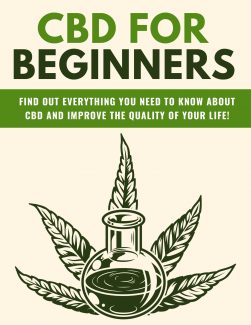 License Type: Private Label Rights
License Type: Private Label Rights  File Type: ZIP
File Type: ZIP
 SKU: 63802
SKU: 63802  Shipping: Online Download
Shipping: Online Download
Sample Content Preview
Introduction
Chances are, you’ve heard about the benefits of using CBD. Perhaps you even have a friend or family member who has turned to CBD in order to help manage their pain.
What you may not know is how CBD actually works, how it can help with different types of chronic pain, as well as a myriad of other ailments, and what formats are available and how to choose the best one for you.
This is why we’ve written this special report, CBD for Beginners.
Throughout the coming chapters, we’ll cover all these topics and more. We’ll also discuss some common myths and misconceptions CBD so you are better informed about the many benefits of CBD and how it can improve the quality of your life.
Let’s begin!
CBD Explained
CBD stands for Cannabidiol. It’s one of over a hundred compounds produced in the resinous flowers of the cannabis plant. The gooey resin is concentrated on the dense clusters of flowers (commonly called buds) of the plant. These are covered by tiny, mushroom-shaped structures known as trichomes.
These trichomes protect the plant from heat and UV radiation. They’re glandular, and create a treasure trove of medicinal compounds, including CBD, THC, and various aromatic terpenes.
The trichome oil also has antifungal, antibacterial, and insecticidal properties that repel pests and predators. The stickiness of the resin also helps by trapping insects.
And contrary to popular belief, CBD isn’t the compound that makes you feel “high” – that’s called tetrahydrocannabinol (THC). CBD is non-addictive, so you don’t need to worry about developing a “habit” from its use.
CBD oil comes from these resinous trichomes of the cannabis flower. However, there are many different strains or varietals of the plant, and the amount of CBD in the flowers depends on which strain you harvest.
Low-resin industrial hemp, which is legally defined as Cannabis with less than 0.03 percent THC by dry weight, has fewer trichomes (and thus, less oil) than high-resin strains do.
However, most high-resin strains nowadays are THC-dominant with little CBD. Therefore, it’s important to choose an appropriate CBD-rich Cannabis strain
Once you have a CBD-rich source, you then extract the oil. There are several ways to do this and each has its pros and cons.
The purpose of this extraction is to make the CBD and other beneficial components of the flower available in a highly concentrated form. Because the cannabinoids are naturally oily, separating the CBD from the plant material creates a thick, potent oil.
CBD is soluble in both oil and alcohol. Thus, the process of extraction usually uses a chemical that can dissolve an oil or alcohol-based compound. These chemicals include supercritical CO2, ethanol, hydrocarbons like butane, and common olive oil.
CO2 extraction is one of the safest methods, and it’s the one most commonly used commercially. Under high pressure and fluctuating temperature, CO2 becomes a liquid which can flush out the active ingredients of the plant matter.
This method is very effective because each compound in the oil can only be extracted by CO2 under very specific temperatures and pressures. This means you can fine-tune the process to extract pure CBD instead of a chemical stew.
Ethanol extraction has been used in many cultures for centuries. In 1854, the US Pharmacopeia recommended ethanol-based tinctures of “Indian hemp” to treat many ailments (including anxiety, depression, pain, and even muscle spasm).
Until 1937, when the Marijuana Tax Act was passed, these tinctures were commonly sold and used by the public, and in recent years, ethanol extraction has once again become popular.
Today, food-grade grain alcohol is used to create very potent, high-quality CBD-rich oil suitable for oral ingestion.
Hydrocarbon extraction (such as butane, hexane, or propane) has some major advantages as well as disadvantages compared to the other methods.
When done properly, this technique is very effective at separating cannabinoids and terpenes from unwanted plant components like chlorophyll.
However, the hydrocarbons are highly flammable. The potent concentrates of this extraction method, which are inhaled or “vaped,” can be very harmful to the user, especially if they have compromised immune systems.
Finally, olive oil extraction is simple and cheap – and you can do it at home if marijuana is legal in your area! Heat the plant matter in the oven. This will turn THCA into THC and CBDA into CBD. Steep the flowers and leaves in the olive oil.
Then sift, strain, and separate the oil from what’s left of the plant.
Note: This process doesn’t strain out the THC, so this product can produce a “high.” Cannabis-infused olive oil is perishable and should be stored in a dark, cool place so it doesn’t spoil.
How CBD Can Improve Your Life
CBD has been used as a medicine in many cultures for thousands of years. So, how can it help you?
Many consumers today are looking for safer alternatives to prescription drugs and their often harsh side effects. CBD has been proven to provide relief from many chronic conditions without any harmful side effects.}
Let’s take a closer look at just a few ways CBD could help improve the quality of your life:
Chronic Pain
CBD creates anti-inflammatory and pain-relieving effects that quickly help with pain management. It’s been studied in relation with reducing cancer pain, neuropathic pain, fibromyalgia, arthritis, migraines, and other body pain, particularly back and neck pain.








